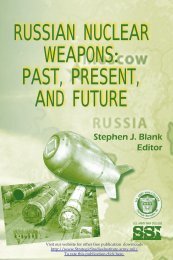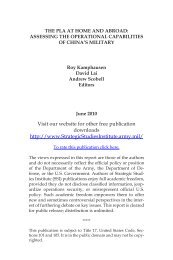The United States and China in Power Transition - Strategic Studies ...
The United States and China in Power Transition - Strategic Studies ...
The United States and China in Power Transition - Strategic Studies ...
Create successful ePaper yourself
Turn your PDF publications into a flip-book with our unique Google optimized e-Paper software.
danger of war because the conditions encourage gambl<strong>in</strong>g. Only<br />
<strong>in</strong> a system where a dom<strong>in</strong>ant nation <strong>and</strong> its allies hold a preponderant<br />
superiority over the rest can peace <strong>and</strong> stability be<br />
assured. Clarity of the “peck<strong>in</strong>g order” promotes peace whereas<br />
relative parity breeds uncerta<strong>in</strong>ty <strong>and</strong>, hence, war. Bruce Bueno<br />
de Mesquita po<strong>in</strong>ts out that the two schools may have missed the<br />
key po<strong>in</strong>t—it is not the distribution of power, but the national decisionmakers’<br />
take on certa<strong>in</strong>ty/uncerta<strong>in</strong>ty that determ<strong>in</strong>es the<br />
course of action. See Bruce Bueno de Mesquita, “Risk, <strong>Power</strong> Distribution,<br />
<strong>and</strong> the Likelihood of War,” International <strong>Studies</strong> Quarterly,<br />
December 1981; <strong>and</strong> <strong>The</strong> War Trap, New Haven, CT: Yale<br />
University Press, 1980. <strong>The</strong> debate, however, is not settled. For<br />
the power transition theory, Organski po<strong>in</strong>ts out that <strong>in</strong> theory,<br />
the dom<strong>in</strong>ant power is more likely to preempt the challenger, but<br />
<strong>in</strong> reality, the latter is responsible for most of the power-transition<br />
wars <strong>in</strong> the past. Steve Chan disputes Organski’s view by provid<strong>in</strong>g<br />
analysis that <strong>in</strong> theory <strong>and</strong> <strong>in</strong> reality, the dom<strong>in</strong>ant power<br />
<strong>in</strong>itiates the fight. See Steve Chan, <strong>Ch<strong>in</strong>a</strong>, the U.S., <strong>and</strong> the <strong>Power</strong>-<br />
<strong>Transition</strong> <strong>The</strong>ory, New York: Routledge, 2008.<br />
7. Thucydides, <strong>The</strong> History of the Peloponnesian War, New York:<br />
Pengu<strong>in</strong> Books, 1954, emphasis added.<br />
8. Spr<strong>in</strong>g <strong>and</strong> autumn is the Ch<strong>in</strong>ese way of characteriz<strong>in</strong>g the<br />
change of seasons <strong>and</strong> time. Confucius used this term as the title<br />
of a chronicle of the State of Lu, Confucius’ home state, <strong>and</strong> one of<br />
the great powers of the time, <strong>and</strong> its relations with the other states<br />
between 722 <strong>and</strong> 481 BC. This period is subsequently named after<br />
this work.<br />
9. <strong>The</strong> name Warr<strong>in</strong>g <strong>States</strong> came from the Record of the Warr<strong>in</strong>g<br />
<strong>States</strong> (战国策), a work compiled early <strong>in</strong> the Han Dynasty<br />
(202 BC-220 AD), cover<strong>in</strong>g mostly warfare <strong>and</strong> <strong>in</strong>terstate relations<br />
among the Ch<strong>in</strong>ese states from 476 BC to the unification of <strong>Ch<strong>in</strong>a</strong><br />
by the Q<strong>in</strong> <strong>in</strong> 221 BC.<br />
10. This term is from John J. Mearsheimer, <strong>The</strong> Tragedy of Great<br />
<strong>Power</strong> Politics, New York: Norton, 2001.<br />
11. For a comprehensive discussion of the Correlates of War<br />
project <strong>and</strong> the datasets, see the follow<strong>in</strong>g publications: J. David<br />
S<strong>in</strong>ger, Stuart Bremer, <strong>and</strong> John Stuckey, “Capability Distribution,<br />
26

















